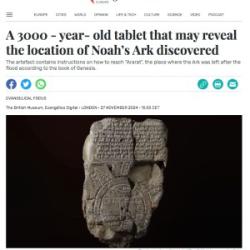We’ve recently discussed white evangelicals’ selective enthusiasm for “biblical archaeology” (see here and here).
Researchers and scholars from all over the world are digging all over the place in the Holy Land, unearthing artifacts that help us to understand all sorts of amazing, fascinating things about this ancient crossroads of civilizations. Every once in a while, some dig will come across something congruent with a biblical story — some mention of a Davidic kingdom, for example — and news of that find gets splashed all over evangelical media here in America. The “news” reported isn’t so much the specifics of that particular discovery, it’s more about the reaffirmation of the Very Wrong notion that — as Michele Bachmann put it — “every archaeology find that has ever come forward has only proved the authenticity of the Bible.”
Bachmann’s claim is only true in the sense that by “come forward,” she — like most American evangelicals — refers only to those finds that align with their expectations. The vast majority of archaeological findings do not align with those expectations are simply ignored and thus have never “come forward.”
Like this one, for example: “Earliest Human Remains Outside Africa Were Just Discovered in Israel.” Researchers from the University of Haifa found a jawbone, a homo sapiens jawbone, “which they’ve dated to somewhere between 177,000 and 194,000 years.”
This find does not “prove the authenticity of the Bible.” Nor, of course, does it disprove the authenticity of the Bible.
Here we should probably unpack Bachmann’s odd phrase. No archaeologist or historian would ever dispute “the authenticity of the Bible” any more than they would dispute “the authenticity of The Iliad.” These are authentically ancient texts. We may not have original manuscripts, but we have some very, very old versions of them, and long, extremely well-documented histories attesting to their existence and circulation going way back.
But of course that’s not what Bachmann or most evangelicals mean when they talk about “the authenticity of the Bible.” What they mean, rather, is that every assertion, description, and event in that ancient text is an “authentic” and accurate representation of something that happened exactly as written. It is, they say, “Literally true.” And that is something that no archaeologist or historian would agree was true of either the Bible or The Iliad.
This claim about “the authenticity of the Bible” isn’t really about the Bible, itself, at all. It’s about one group’s particular interpretive framework for understanding the Bible. It’s about how they choose to read that text. Archaeology isn’t concerned with that framework one way or another — it doesn’t set out to confirm or reject it. It just digs and recovers and finds what it finds. And what it finds, relentlessly, proves that this framework is indefensible. Inauthentic, even.
In any meaningful sense, the staggeringly ancient human jawbone unearthed in Israel’s Mislaya Cave has nothing at all to do with the Bible or with the world of the Bible. It’s from a world that existed at least 170,000 years before the Bible ever existed. But if one’s interpretive framework for reading the Bible is based on the idea that the universe is only 10,000 years old, then a 174,000-year-old jawbone cannot be. And the tangible fact that it is renders your framework unworkable.
Note that the illiterate literalism and pseudo-scientific mumbo jumbo of young-Earth creationism isn’t the only interpretive framework upended by this latest discovery. It also stubbornly refuses to “authenticate” what had been, for a while at least, the prevailing accepted understanding of when it was that we humans first migrated out of Africa. As that Smithsonian report by Lorraine Boissoneault says:
For many years, the consensus view among archaeologists placed the exodus at 60,000 years ago — some 150,000 years after the hominins first appeared. … But this new discovery … if verified … would require reevaluating the whole history of human evolution — and possibly pushing it back by several hundred thousand years.
That’s why scientists find this discovery so giddily exciting. It doesn’t fit with their prior understanding. It threatens to upend what they previously thought they knew. And that, for scientists, is thrilling. They’re going to have to change their previous interpretive framework and they get to learn something new. And for them, learning something new is the whole point.
Isaac Asimov (maybe, or someone, anyway) described this way of thinking by saying: “The most exciting phrase to hear in science, the one that heralds new discoveries, is not Eureka! but That’s funny …” A human jawbone this old, this far from Africa, falls into this category — That’s funny … that’s odd … that’s not what we expected to find. And so it heralds the chance for us to learn something new, to improve our knowledge and our understanding.
The kind of fundamentalist mindset that denies everything that fails to confirm its pre-existing understanding views this as a weakness in science. See, those worldly fools are constantly changing their theories to account for new facts! That proves all their theories have been wrong, just like we’ve always said! Far better, in this way of thinking, to insist that one already has all the facts and theories one will ever need, and to perceive every opportunity to learn something new as a threat to be dismissed or denied.
That way of thinking precludes the possibility of learning — of ever knowing more than you know right now, at this moment. That is, you know, not good.

















